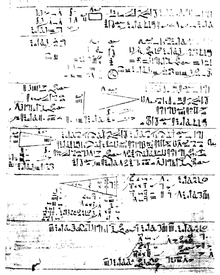Mathematics
- Afrikaans
- Alemannisch
- አማርኛ
- Aragonés
- Ænglisc
- अंगिका
- العربية
- الدارجة
- مصرى
- অসমীয়া
- Asturianu
- Kotava
- अवधी
- Aymar aru
- Azərbaycanca
- تۆرکجه
- Башҡортса
- Boarisch
- Žemaitėška
- Bikol Central
- Беларуская
- Беларуская (тарашкевіца)
- Български
- भोजपुरी
- Bislama
- Banjar
- ပအိုဝ်ႏဘာႏသာႏ
- Bamanankan
- বাংলা
- བོད་ཡིག
- বিষ্ণুপ্রিয়া মণিপুরী
- Brezhoneg
- Bosanski
- Basa Ugi
- Буряад
- Català
- Chavacano de Zamboanga
- 閩東語 / Mìng-dĕ̤ng-ngṳ̄
- Нохчийн
- Cebuano
- Chamoru
- کوردی
- Corsu
- Qırımtatarca
- Čeština
- Kaszëbsczi
- Словѣньскъ / ⰔⰎⰑⰂⰡⰐⰠⰔⰍⰟ
- Чӑвашла
- Cymraeg
- Dansk
- Dagbanli
- Deutsch
- Thuɔŋjäŋ
- Zazaki
- Dolnoserbski
- Kadazandusun
- ދިވެހިބަސް
- Ελληνικά
- Emiliàn e rumagnòl
- English
- Esperanto
- Español
- Eesti
- Euskara
- Estremeñu
- فارسی
- Suomi
- Võro
- Na Vosa Vakaviti
- Føroyskt
- Français
- Arpetan
- Nordfriisk
- Furlan
- Frysk
- Gaeilge
- 贛語
- Kriyòl gwiyannen
- Gàidhlig
- Galego
- Avañe'ẽ
- गोंयची कोंकणी / Gõychi Konknni
- Bahasa Hulontalo
- ગુજરાતી
- Gaelg
- Hausa
- 客家語 / Hak-kâ-ngî
- Hawaiʻi
- עברית
- हिन्दी
- Hrvatski
- Kreyòl ayisyen
- Magyar
- Հայերեն
- Interlingua
- Jaku Iban
- Bahasa Indonesia
- Interlingue
- Igbo
- Ilokano
- ГӀалгӀай
- Ido
- Íslenska
- Italiano
- 日本語
- Patois
- La .lojban.
- Jawa
- ქართული
- Qaraqalpaqsha
- Taqbaylit
- Kumoring
- Қазақша
- Kalaallisut
- ភាសាខ្មែរ
- ಕನ್ನಡ
- 한국어
- Къарачай-малкъар
- कॉशुर / کٲشُر
- Kurdî
- Kernowek
- Кыргызча
- Latina
- Ladino
- Lëtzebuergesch
- Лезги
- Lingua Franca Nova
- Luganda
- Limburgs
- Ligure
- Ladin
- Lombard
- ລາວ
- Lietuvių
- Latviešu
- Madhurâ
- मैथिली
- Basa Banyumasan
- Malagasy
- Олык марий
- Minangkabau
- Македонски
- മലയാളം
- Монгол
- ꯃꯤꯇꯩ ꯂꯣꯟ
- ဘာသာမန်
- मराठी
- Bahasa Melayu
- Malti
- Mirandés
- မြန်မာဘာသာ
- Эрзянь
- مازِرونی
- Nāhuatl
- Plattdüütsch
- Nedersaksies
- नेपाली
- नेपाल भाषा
- Li Niha
- Nederlands
- Norsk nynorsk
- Norsk bokmål
- Novial
- Nouormand
- Diné bizaad
- Occitan
- Livvinkarjala
- Oromoo
- ଓଡ଼ିଆ
- Ирон
- ਪੰਜਾਬੀ
- Pangasinan
- Kapampangan
- Papiamentu
- Picard
- पालि
- Norfuk / Pitkern
- Polski
- Piemontèis
- پنجابی
- پښتو
- Português
- Runa Simi
- Română
- Armãneashti
- Русский
- Русиньскый
- संस्कृतम्
- Саха тыла
- ᱥᱟᱱᱛᱟᱲᱤ
- Sardu
- Sicilianu
- Scots
- سنڌي
- Srpskohrvatski / српскохрватски
- Taclḥit
- සිංහල
- Simple English
- Slovenčina
- سرائیکی
- Slovenščina
- Gagana Samoa
- ChiShona
- Soomaaliga
- Shqip
- Српски / srpski
- Sranantongo
- SiSwati
- Seeltersk
- Sunda
- Svenska
- Kiswahili
- Ślůnski
- தமிழ்
- ತುಳು
- ᥖᥭᥰ ᥖᥬᥲ ᥑᥨᥒᥰ
- తెలుగు
- Tetun
- Тоҷикӣ
- ไทย
- Türkmençe
- Tagalog
- Tolışi
- Setswana
- Tok Pisin
- Türkçe
- Xitsonga
- Татарча / tatarça
- Удмурт
- Українська
- اردو
- Oʻzbekcha / ўзбекча
- Vèneto
- Vepsän kel’
- Tiếng Việt
- West-Vlams
- Volapük
- Walon
- Winaray
- Wolof
- 吴语
- Хальмг
- IsiXhosa
- მარგალური
- ייִדיש
- Yorùbá
- Vahcuengh
- Zeêuws
- ⵜⴰⵎⴰⵣⵉⵖⵜ ⵜⴰⵏⴰⵡⴰⵢⵜ
- 中文
- 文言
- 閩南語 / Bân-lâm-gú
- 粵語
- IsiZulu
Aujaar
General
Chhaapo/export karo
Duusra project me
Appearance
Wikipedia se

Mathematics (jiske chhota kar ke "maths" nai to "math" bola jaae hae), number, shape aur pattern ke study hae.
"https://hif.wikipedia.org/w/index.php?title=Mathematics&oldid=236051" se lawa gais hae
